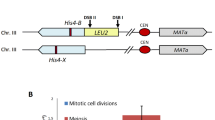Summary
The RAD6, RAD50, and RAD52 loci have been identified as genes which code for functions which may act during meiotic recombination in yeast (Game et al. 1980; Prakash et al. 1980). By use of the spo13-1 mutation, which allows sporulating cells to bypass the first meiotic division, the rad50-1 mutation has been directly implicated as a general meiotic Rec- mutation by examination of viable ascospores (Malone and Esposito 1981). Since the rad6-1 and rad52-1 mutations do not yield viable ascospores in the presence of spo13-1, multiple rad mutants have been constructed and analyzed. This analysis has demonstrated that in meiosis rad50-1 is epistatic to rad52-1, and rad6-1 is epistatic to rad50-1. This suggests that the order of action of these genes during meiosis is RAD6, RAD50, and then RAD52. The data for rad6-1 can be interpreted to suggest that RAD6 may not code for a recombination function, per se, although it may be required for recombination to occur. Analysis of mitotic recombination indicates that rad52-1 is epistatic to rad50-1; in mitosis; this is consistent with the hypothesis that the RAD50 gene codes for a recombination function required in meiosis but not in mitosis.
Similar content being viewed by others
References
Baker B, Carpenter A, Esposito M, Esposito RE, Sandler L (1976) The genetic control of meiosis. Ann Rev Genet 10:53–134
Clark AJ (1971) Toward a metabolic interpretation of genetic recombination of E. coli and its phages. Ann Rev Microbiol 25:437–464
Demerec M, Adelberg E, Clark AJ, Hartman P (1966) A proposal for a uniform nomenclature in bacterial genetics. Genetics 54:61–76
Dressler D, Potter H (1976) On the mechanism of genetic recombination: The maturation of recombination intermediates. Proc Natl Acad Sc USA 74:4168–4173
Game JC, Zamb TS, Braun R, Resnick M, Roth R (1980) The role of radiation (rad) genes in meiotic recombination in yeast. Genetics 94:51–68
Golin J, Esposito M (1977) Evidence for joint genic control of spontaneous mutation and genetic recombination during mitosis in Saccharomyces. Mol Gen Genet 150:127–135
Hereford L, Hartwell L (1974) Sequential gene function in the initiation of Saccharomyces cerevisiae DNA synthesis. J Mol Biol 84:445–461
Holliday R (1964) A mechanism for gene conversion in fungi. Gent Res 5:282–304
Jackson JA, Fink GR (1981) Gene conversion between duplicated genetic elements in yeast. Nature 292:306–311
Klar A, Fogel S, Macleod K (1979) MAR1-A regulator of the HMa and HMα loci in Saccharomyces cerevsiae. Genetics 92:37–50
Klapholz S (1980) The genetic control of chromosome segregation during meiosis in yeast. Ph. D. Thesis, Dept. of Biology, University of Chicago, Chicago, IL
Klapholz S, Esposito RE (1980a) Isolation of spo12-1 and spo13-1 from a natural varient of yeast that undergoes a single meiotic division. Genetics 96:589–611
Klapholtz S, Esposito RE (1980b). Recombination and chromosome segregation during the single division meiosis in spo12-1 and spo13-1 diploids. Genetics 96:589–611
Malone RE, Esposito RE (1980) The RAD52 gene is required for homothallic interconversion of mating types and spontaneous mitotic recombination in yeast. Proc Natl Acad Sci USA 77:503–507
Malone RE, Esposito RE (1981) Recombinationless meiosis in yeast. Mol Cell Biol 1:891–901
Malone RE, Golin J, Esposito M (1980) Mitotic versus meiotic recombination in Saccharomyces cerevisiae. Curr Genetics 1:241–248
Meselson M, Radding C (1975) A general model for genetic recombination. Proc Natl Acad Sci USA 72:358–361
Montelone B, Prakash S, Prakash L (1981) Recombination and mutagenesis in rad6 mutants of Saccharomyces cerevisiae: Evidence for multiple functions of the Rad6 gene. Mol Gen Genet 84:410–495
Mortimer RK, Contopoulous R, Schild D (1981) Mitotic chromosome loss in a radiation-sensitive strain of the yeast Saccharomyces cerevisiae. Proc Natl Acad Sci USA 78:5778–5782
Plischke M, Von Borstel R, Mortimer R, Cohn W (1976) Genetic markers and associated gene products in S. cerevisae. In: Fasman G (ed) Handbook of Biochem and Mol Biol. CRC Press, Cleveland, OH
Prakash S, Prakash L, Burke W, Montelone B (1980) Effects of the RAD52 gene on recombination in Saccharomyces cerevisiae. Genetics 94:31–50
Prakash L, Taillon-Miller P (1981) Effects of the rad52 gene on sister chromatid recombination in Saccharomyces cervisiae. Curr Genet 3:247–250
Strathern J, Blair L, Herskowitz I (1979) Healing of mat mutations and control of mating type interconversion by the mating type interconversion by the mating type locus in Saccharomyces cerevisiae. Proc Natl Acad Sci USA 76:3425–3429
Wagstaff J, Klapholz, S, Esposito RE (1982). Meiosis in haploid yeast. Proc Natl Acad Sci USA 79:2986–2990
Zamb T, Petes T (1981) Unequal sister-strand recombination within yeast ribosomal DNA does not require the RAD52 gene product. Curr Genet 3:125–132
Author information
Authors and Affiliations
Additional information
Communicated by G.R. Fink
Rights and permissions
About this article
Cite this article
Malone, R.E. Multiple mutant analysis of recombination in yeast. Molec. Gen. Genet. 189, 405–412 (1983). https://doi.org/10.1007/BF00325902
Received:
Issue Date:
DOI: https://doi.org/10.1007/BF00325902




